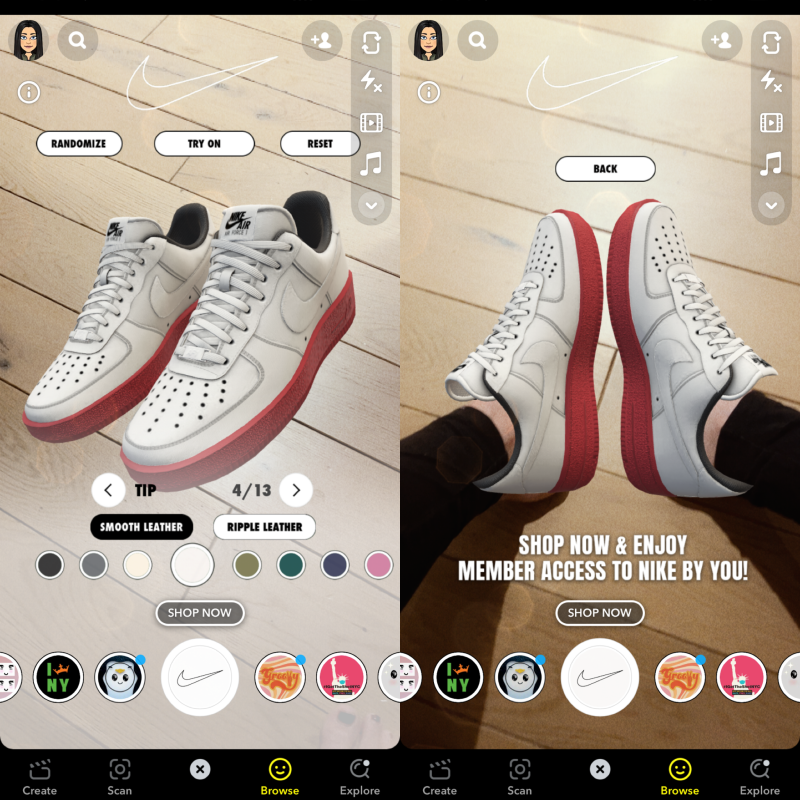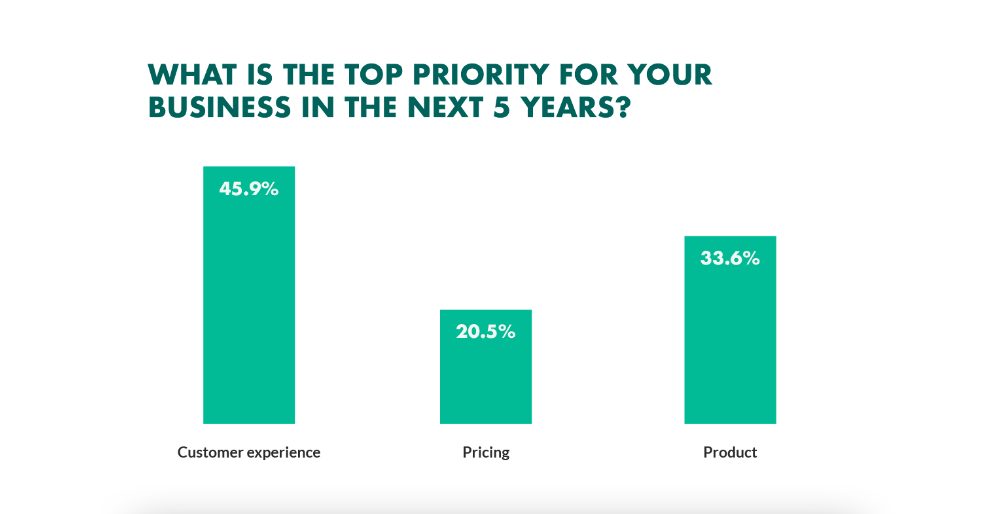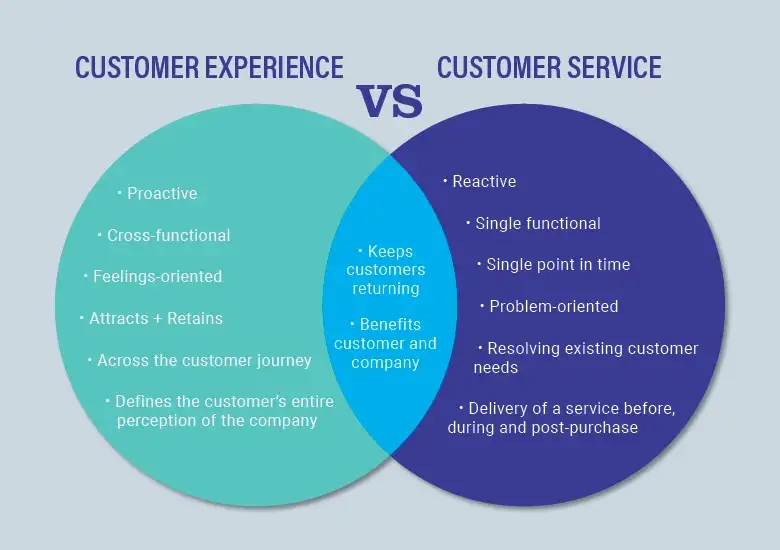Customer Experience in Retail Guide: Strategies and the Future of CX

Last updated on February 4, 2025
Let’s face it; running a retail business is unforgiving work. First, your brand needs to compete against hundreds of others in a crowded marketplace. Meanwhile, customers are rolling in options and will drop a brand for its competition the moment they have a negative experience. That’s why creating a customer experience (CX) that helps your business stand out is essential.
Last year, the CX management market was already worth $11.4 billion. With a 12.2% compound annual growth rate (CAGR), it is expected to reach $20.4 billion by 2028.
Companies are investing serious money into CX because excellent CX is quickly becoming a key expectation of consumers. A survey by Gartner found CX drives 66% of customer loyalty, making it more influential in deciding where customers shop than price and brand name combined.
Whether you operate a physical or online store, developing a winning CX strategy is one of the best ways to ensure your business thrives. Grow your customer base and your company’s bottom line by delivering the best retail CX in your segment. And if you need a little help, you can always reach out to the experts.
In This Article:
What is Customer Experience in Retail, and Why is it Important?
The customer experience (CX) is a customer’s impression of an organization or brand based on their interactions with you. It is the sum of all customer interactions with a company or brand, from their first contact to post-purchase follow-up.
While customer experience is still important, the way someone interacts with you is different from what it was a decade ago. Technology, mainly eCommerce, has changed the way people shop. There are now multiple touchpoints for your customers–websites, apps, and newsletters in addition to your physical space (and they may never even set foot in your store!).
Because of this complexity, the retail customer journey must be consistent across all touchpoints (website design, apps, physical space, etc.). Consistency is what customers want and expect, providing them with a great experience.
Customer experience can make or break relationships between companies and customers. A positive experience builds loyalty and trust, increases sales, and improves customer satisfaction. A bad CX can motivate customers to abandon the brand altogether.
Distinguishing Between CX and Customer Service
It’s common to think of CX and customer service as interchangeable concepts. But even though both fields are concerned with keeping customers happy while benefiting the brand, there are some important distinctions between the two. Knowing what falls under which category will help develop a CX strategy that adds real value to your business.
Customer service is the direct interaction between a company and its customers. Customer experience is about a customer’s perception or feeling of the company. Let’s put it another way. Customer service focuses on specific interactions, like resolving complaints or answering questions. You can think of customer service as a point on a timeline.
Customer experience is the line itself. It takes into account all touchpoints during the purchasing process. CX includes product quality, ease of use, pricing, delivery speed, and more.
Impact of Global Events on Retail Customer Experience
The global pandemic of 2020 flipped the retail industry on its head. While the economy entered a collective recession, the eCommerce industry saw a boom as online shopping replaced physical purchases.
While the 2020 recession is the shortest on record, there is no doubt that inflation has become a major concern for consumers across all industries, including retail. Experts believe the modern retail industry will follow a similar pattern as it did during the 2009 recession.
Even as the global economy recovers from the pandemic, certain consumer habits, like a newfound preference for shopping online, are here to stay. That means if brands want to retain the customers they’ve gained by growing their digital stores, it’s time to spend on CX. A post-pandemic report from 2021 by Forrester, a market research firm, found that satisfactory CX contributed to 2.4 times higher customer loyalty for brands.
Innovative Strategies to Enhance Customer Experience in Retail
It’s one thing to say, “We’ll give our customers a great experience!” It’s another to make a strategic plan and put it in place. Reaching your goals of customer loyalty and increased revenue requires a mix of proven strategies and experimental approaches.
Five Proven Techniques for CX Success
Here are a few reliable methods for creating the best CX possible:
-
Know Your Customer
Understanding your customers is essential to any business’s success. Knowing who your customers are and what they want means you can create better products to meet their needs. When you meet their needs, they enjoy the experience.
One of the most important ways to understand your customers is by collecting data about them. This could be data like demographics, sale history, website visits, and more, as this information provides businesses with valuable insights. Businesses can then tailor marketing strategies and product offerings for the greatest customer satisfaction.
-
Create a Consistent Customer Journey
Consistent journeys allow retailers to ensure that customers have the same experience regardless of which touchpoint they interact with. This will increase customer satisfaction and loyalty and help build trust between your brand and your customers. Retailers can create an environment where customers feel comfortable and valued through this process. This helps customers make purchases more often.
Increased conversion rates are another benefit of consistent customer journeys. Customers will more easily identify each step they take and are less likely to make a snap decision. This process creates new sales opportunities like up-selling, cross-selling, and impulse purchases.
-
Modernize Your Technology
Many exciting new developments in consumer technology have revolutionized the retail experience in 2024, including retail software development solutions that enable personalized, interactive, and seamless shopping experiences. Some notable features consumers are becoming used to interacting with are AI retail assistant chatbots and retail mobile apps, which provide personalized and interactive online shopping experiences, and augmented reality (AR) shopping. 
-
Measure Customer Satisfaction
Tracking key metrics is vital to improving your CX performance. This information helps improve the quality of service you provide, which, in turn, will lead to higher levels of customer loyalty and retention. Some important metrics that indicate how you well your CX is performing include:
-
Implement a Loyalty Program
Loyalty programs, as the name implies, are specifically designed to increase customer loyalty. And it’s one of the easiest and most effective ways to do so. A loyalty program can reward customers for their frequent purchases and encourage them to come back for more.
These programs can be used to reward customers with discounts, special offers, freebies, or other incentives that will make them feel appreciated. Additionally, loyalty programs can also help businesses track customer data so they can better understand their needs and provide tailored services accordingly.
New CX Strategies for the Digital Age
In one of Lumoa’s webinars – Transforming Customer Experience in Retail: From Insights to Actionable Metrics and Back, Matthieu Bonelli explores the power of integrating insights and actionable metrics to enhance customer experience in the retail sector. Highlighting the critical role of breaking down silos between digital and physical retail spaces, Bonelli provides practical examples of how unified team efforts and customer journey mapping can create consistent and memorable brand experiences.
This segment not only reinforces the importance of leveraging technology as outlined in the introduction but also exemplifies the application of these new CX strategies in a real-world context, offering a comprehensive roadmap for businesses aiming to thrive in the digital age.
Your business needs to use all the tools at its disposal. Using the latest technology and software solutions, your brand can build a next-generation CX that builds loyalty and drives sales. Here are some of the latest trends in CX that can have a positive impact on your business:
-
Personalizing the Retail Experience
Giving customers a personalized shopping experience is one of the best ways to keep them returning to your store for more. A survey found that 88% of all online shoppers prefer buying from websites that offer a personalized experience.
-
Phygital Retail
Despite the rise in online shopping, some consumers still prefer buying from brick-and-mortar stores. Your company can enrich their retail experience by offering digital upgrades to its physical journey through the store, such as QR codes displaying product information, enabling online purchases through a digital catalogue and store pick-ups, and contactless payment options.
-
Measuring and Improving Customer Experience Across Channels
To deliver a seamless shopping experience, CX needs to remain consistent across channels. Your customers should be able to pursue their requests through whichever mode of communication they prefer, either on social media, the company website, or any other platform. Additionally, you can create an online FAQ page to provide readily available answers to common questions, reducing wait times and empowering customers to find solutions independently. Alternatively, you can collect their email addresses, validate them using email verification tools, and send a feedback form to gather their feedback.
Having a clear omnichannel messaging strategy also helps your business reach more consumers in different segments, bringing your brand greater exposure and the opportunity to see more sales conversions.
The Future of Customer Experience in Retail
 The retail industry is changing rapidly, and customer experience is at the forefront of this transformation. Over 45% of companies believe customer experience will be their top priority for the next five years. It’s not an exaggeration to say that your future depends on your customer experience strategy.
The retail industry is changing rapidly, and customer experience is at the forefront of this transformation. Over 45% of companies believe customer experience will be their top priority for the next five years. It’s not an exaggeration to say that your future depends on your customer experience strategy.
As customers become more informed and demanding, retailers are turning to data-driven marketing strategies to deliver personalized experiences that keep customers coming back.
Customer experience analytics help retailers gain insights into their customers’ behavior and preferences. This data is powerful. It allows you to create targeted campaigns that get better engagement. Your customers will take more interest in these campaigns. And that’s more likely to drive sales and increase customer loyalty.
Having a CX strategy that works for your business is an ongoing process. And Lumoa is the perfect partner for your journey. Check out our cx solutions, and we’ll help you start managing your CX today.
